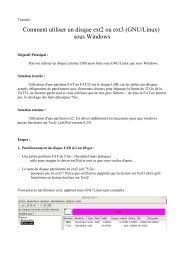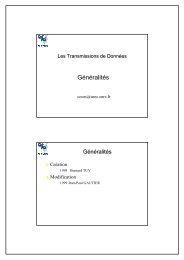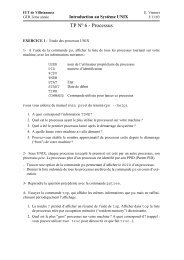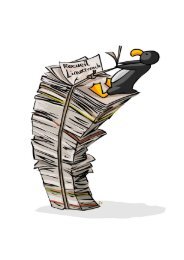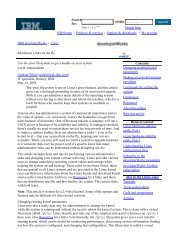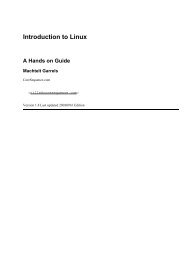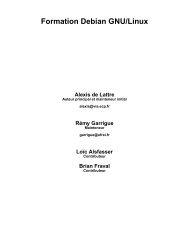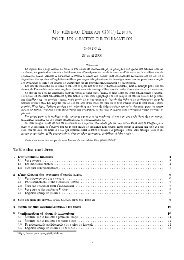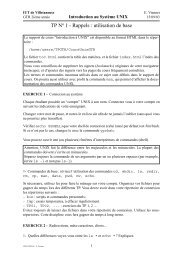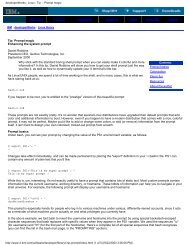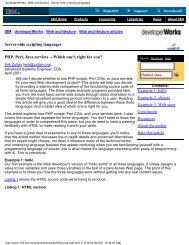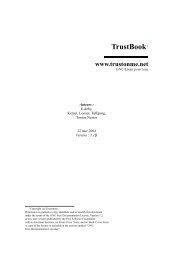Tcl/Tk quick start - Free
Tcl/Tk quick start - Free
Tcl/Tk quick start - Free
You also want an ePaper? Increase the reach of your titles
YUMPU automatically turns print PDFs into web optimized ePapers that Google loves.
Presented by developerWorks, your source for great tutorials<br />
ibm.com/developerWorks<br />
% place .one -x 5 -y 70<br />
% place .two -x 5 -y 90<br />
% text .twindow -width 22 -height 14 -font {clean -14}<br />
.twindow<br />
% place .twindow -x 5 -y 120<br />
% button .ok -command {process_data $SlidVal} -text "OK"<br />
.ok<br />
% button .cancel -command {exit} -text "Cancel" -backgroun<br />
.cancel<br />
% place .ok -x 15 -y 350<br />
% place .cancel -x 120 -y 350<br />
<strong>Tk</strong> commands, Part 1<br />
There are over 20 <strong>Tk</strong> commands, that act on, enhance, or complement the <strong>Tk</strong> widget set.<br />
These include bell, which rings the bell, depending on the configuration of the X Window<br />
system that's running. bind creates an association between a <strong>Tcl</strong> script and X events; for<br />
example, a specific key-mouse combination action. clipboard is another of the multi-function<br />
<strong>Tk</strong> commands -- it contains all the code for clearing, loading, and pasting contents to and<br />
from the <strong>Tk</strong> clipboard (which is distinct from any clipboard features native to either X or the<br />
window manager you're using).<br />
destroy is used to delete a window and all of its children. Used on the '.' (root) window, it<br />
deletes the entire application. event is a powerful tool for generating virtual window events<br />
and inserting them into the processing queue, as though the actual event (a mouse click on a<br />
button, for example) had happened for real. The font command is used to create specified<br />
instances of system fonts. It permits local (to the script) naming of system fonts, attribute<br />
modification of named fonts, and "deletion" of fonts. Type font families at a wish prompt for<br />
a listing of available fonts for use.<br />
Focus is an important concept in the window management arena -- in any given display, only<br />
one window at a time may have the "attention" of the keyboard and mouse. The <strong>Tk</strong> focus<br />
command is used to give the script control over the display focus, sending it to specified<br />
windows. A complementary function, grab, allows <strong>Tk</strong> to monopolize the display focus to the<br />
point where events outside the window are reported within the window's environment. This is<br />
useful when you want to force completion of an option prior to any other system activity<br />
taking place.<br />
<strong>Tk</strong> commands, Part 2<br />
Continuing with our overview of <strong>Tk</strong> commands, next up is grid, an interface to the <strong>Tk</strong> window<br />
geometry master. It is used to order widgets in a window in a rows and columns format.<br />
lower (and the complementary command raise) mediate sub-window visibility. A lowered<br />
window obscures none of its overlapping sibling windows; a raised window is brought to the<br />
top. This is used frequently in multi-document display situations. Many of the <strong>Tk</strong> widgets and<br />
commands work from a common set of standard options. These may be viewed or added to<br />
by the option command.<br />
For putting widgets and sub-windows inside a window, there are two commands, both of<br />
which have already been demonstrated: pack and place. In its simplest use, pack adds one<br />
or more widgets to a window, and unless otherwise instructed, shrinks the window around<br />
<strong>Tcl</strong>/<strong>Tk</strong> <strong>quick</strong> <strong>start</strong> Page 18 of 29



